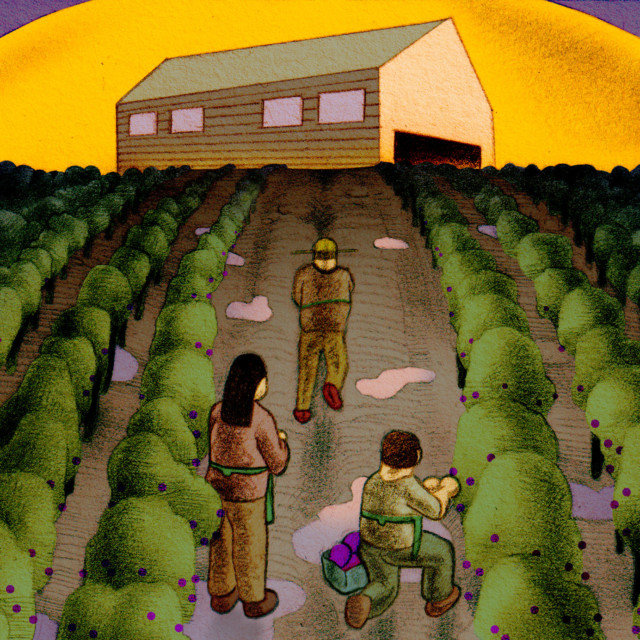The freak winter storm that rocked Texas in February 2021 left an immediate impact in myriad ways. The data proves this: Between $80 and $130 billion in estimated damage was left in its aftermath; more than 10 million Texas residents lost power, some for several days; 210 residents sadly lost their lives. Calls for Texas to overhaul its energy infrastructure rose promptly and, even after some legislative reform, are ongoing.
The storm’s long-term impact on the Texas wine industry remained a mystery at the time, though there was a sense of cautious optimism among Lone Star State vintners when VinePair spoke with a few Texas wineries in March. There was a reason for this: The extreme weather hit the state’s grape-growing epicenter — the Texas High Plains — when the vines were dormant, and this period of slumber afforded the plants natural protection from the elements. Still, this positivity was underscored by the realization that a full assessment of the storm’s fallout wouldn’t be possible until harvest time.
Fast forward to November, and the vintners have answers. Harvest in Texas wine country wrapped up between late September and early October, and the wineries have now had a few weeks to gauge the full effects of the storm’s aftermath. So, what’s the verdict?
Justified Positivity
For the most part, the positive outlook among Texas wineries was justified. “This has been a strong harvest when everything’s all said and done,” says Julie Kuhlken, co-founder and chief marketing and hospitality officer of Pedernales Cellars in Stonewall. “We have seen some reductions, but we are looking at getting around 90 percent of the fruit we contracted.” Since it’s not uncommon for Texas wineries to purchase grapes from non-estate vineyards, a percentage this high can represent an impressive bounty.
“This year will be our largest harvest ever,” adds Bob Young, co-owner and winemaker of Bending Branch Winery in Comfort. “It has also been our longest harvest ever.”
2021’s harvest wasn’t just strong. It was clutch. The region had already gone through viticultural hell in 2020, when an early fall freeze shrank winery yields for the vintage by as much as 60 percent. Even though the potential for low yields looms over the region annually due to wildly unpredictable weather conditions — one of the reasons why the state’s wines aren’t usually seen outside of Texas and its surrounding states — the vintage’s reduced numbers were low enough to make a robust 2021 harvest a near-necessity. It delivered on this need in a big way, thanks to a summer marked by abundant rainfall and, ironically enough, unexpectedly cooler temperatures sweeping over the Texas High Plains.
These conditions did more than just sustain the conditions necessary to produce enough fruit for a bounce-back harvest. They also produced excellent quality that some feel may rival some of the state’s best vintages. “The rain and cooler temperatures resulted in exceptional fruit with good acid and flavors,” says Ron Yates, owner of Spicewood Vineyards. “I think the 2021 vintage could rival the 2017 vintage, which was one of the best in Texas history.”
A Few Hiccups
But Texas wineries didn’t make it through the freeze completely unscathed; some venues experienced yield reductions. “The quality of our Sangiovese is there, but the yield was not,” says Dave Reilly, winemaker for Duchman Family Winery in Driftwood. “That’s 100 percent due to the freeze.”
Spicewood experienced some issues with estate-grown vines planted in Texas Hill Country, the area just west of Austin that a healthy chunk of the state’s wineries call home. “We received no fruit from our estate vineyard,” Yates says. “Our 28-plus-year-old vines were already suffering from Pierce’s Disease, and they just could not survive the cold.”
Additionally, Pedernales lost some of its newer Tempranillo plantings. “But this wasn’t [surprising] given that Tempranillo is not very hearty in cold weather during its first two years in the ground,” says Kuhlken.
Telling Texas Tales
Despite these issues, the good that blossomed from the 2021 harvest far outweighs the bad. The cautious optimism that permeated through the Texas wine scene in the wake of last winter’s brutal weather event was indeed realized.
But even if the harvest had been a weather-beaten dud, a different form of optimism would have likely taken its place; the kind that compels the people producing Texas wine to produce what they can every year — regardless of what conditions the Lone Star State has in store. “Every single vintage tells a story, regardless of weather events,” Reilly says. “We will continue to do our best with what each vintage gives us to work with. It’s what we do.”
This story is a part of VP Pro, our free platform and newsletter for drinks industry professionals, covering wine, beer, liquor, and beyond. Sign up for VP Pro now!
